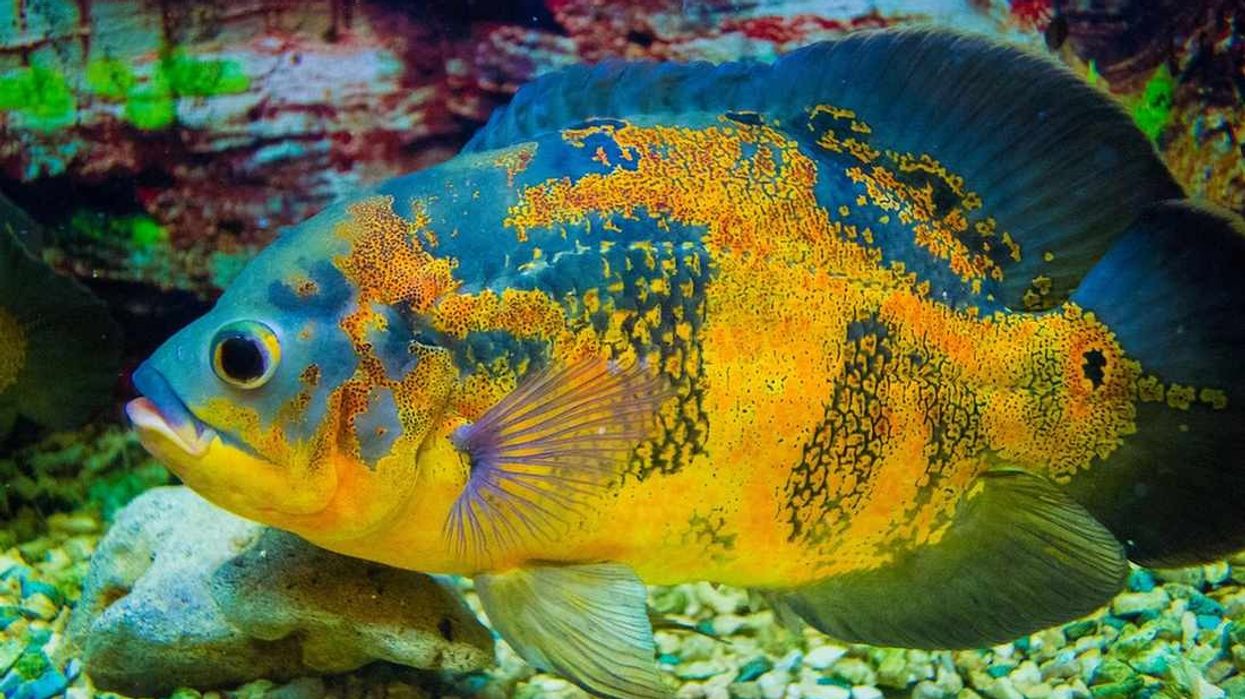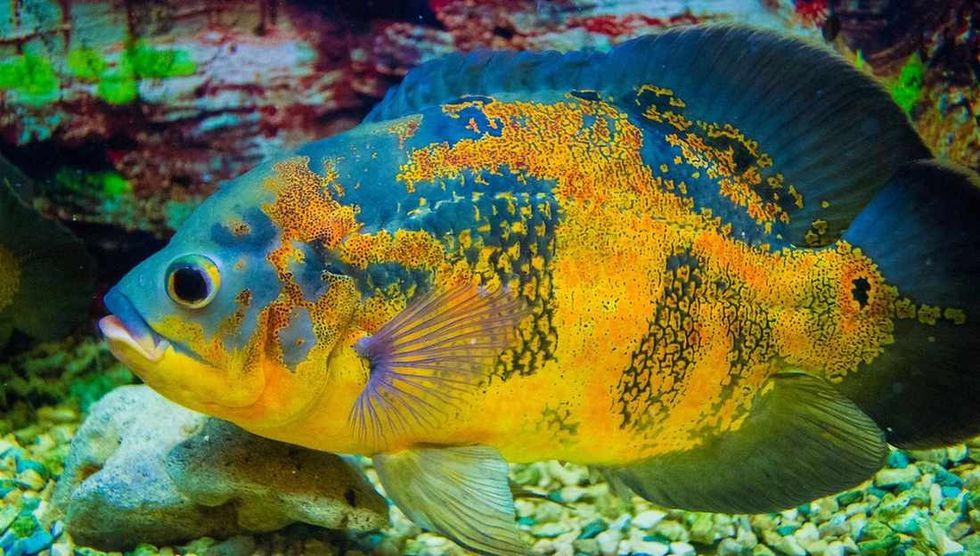Are you looking for a lively fish for your aquarium? Well, look no further as we bring you an intelligent, bright, and energetic cichlid in the form of the Tiger Oscar.
The Tiger Oscar is one of the most popular species of freshwater cichlid fish in the aquarium trade. In the wild, their habitat is the Amazon River in South America. Their scientific name is Astronotus ocellatus.
They are also popular with other names like Marble Cichlid, and Velvet Cichlid. As tropical freshwater fish, higher temperatures are best suited for their survival in the wild and the aquarium's artificial environment.
The breeding season is summer when temperatures soar above 25 degrees Celsius. The Tiger Oscars are viviparous, and fertilization happens externally. These cichlid species can reproduce for as long as 9-10 years.
The Tiger Oscar diet in common comprises catfish, worms, crayfish, insects, and plant debris. The ideal size for a Tiger Oscar aquarium can be a 55-75 gallon tank to provide a stress-free environment for these fishes. Read on to know all about the Tiger Oscar.
If you find our content here exciting, then check out more fun information on ladyfish and varied thrush too.
Tiger Oscar Interesting Facts
What type of animal is a Tiger Oscar?
The Tiger Oscar is a freshwater fish that is very popular in the aquarium trade, also termed an intelligent fish. The Oscar Cichlid is known by various common names, including Marble Cichlid, Velvet Cichlid, and Red Oscar. These cichlids are known to recognize their owners. They exhibit their recognition of owners by responding to their sounds and sight.
What class of animal does a Tiger Oscar belong to?
The Tiger Oscar cichlid belongs to the Actinopterygii class in the Animal kingdom. The distinctive feature of this class of ray-finned fish is the presence of a rigid skeleton, a swim bladder providing buoyancy in the water, and a gill cover to pump water to the gills fish when not swimming too.
How many Tiger Oscars are there in the world?
As these Oscar cichlid fish are abundantly bred for the aquarium trade, there is no specific study done to ascertain their population counts on large. It is safe to assume that these Oscar cichlids are well-preserved and have a healthy population count worldwide.
Where does a Tiger Oscar live?
The Velvet Cichlid or the Marble Cichlid Oscars are chiefly found in the Amazon river basin in South America. Their habitat range is spread across South America in the countries like Argentina, Colombia, Peru, Uruguay, and Brazil, along with parts of French Guiana and Surinam.
The Tiger Oscar cichlid population has been artificially introduced to parts of Asia, North and Central parts of America, and Africa.
What is a Tiger Oscar's habitat?
The Tiger Oscar cichlid is found in tropical waters with temperatures ranging between 22-25 degrees Celsius. They inhabit shallow and calm freshwater river basins. They prefer to live in swampy or sandy substrates.
Who do Tiger Oscars live with?
The Tiger Oscar cichlid is a very social fish. They are known to frequently associate with other members of their species for varied reasons. They are highly territorial and very motile as they defend their zones with great vigor and zeal. In the process of territory marking, they are seen to develop a dominance hierarchy.
How long does a Tiger oscar live?
Tiger Oscar lifespan is of 10-20 years making them a hardy fish for any tank or aquarium owner. The Astronotus ocellatus is low on maintenance and has the longevity of life. Given the ideal condition and reasonable maintenance of their artificial habitats, the Astronotus ocellatus live a long and healthy life.
The key to providing a longer and healthier life is identifying their behavior patterns to anticipate their sickness or grave health issues.
The signs to watch out for a sick or dying Tiger Oscar are dull behavior, change in their appearance or color, change in feeding patterns, the introduction of wrong Tiger Oscar tankmates causing food scarcity due to competition, and changes in temperament swimming.
The solution lies in the fact that you need to ensure the aquarium water is changed at regular intervals; maintaining optimum water temperature and decors for the fish is also important. The tank partners are also a crucial part of the survival strategy.
The ideal tank pals for these cichlids are Silver Dollar fish, Catfish, Convict cichlids, Firemouth cichlids, and Blue Acara.
How do they reproduce?
These species of cichlids are sexually mature after 14 months of age. The spawning season occurs when the temperatures are warmer above 25 degrees Celsius.
There are three to four cycles of breeding per year. Before breeding starts, the male and female prepare the nesting site for an egg to be laid, and when spawning starts, they move alongside one another by spreading fins.
The female Tiger Oscar lays eggs in the range of 300-3000. External fertilization occurs, and the Tiger Oscar eggs hatch in two to three days. The young cichlids are under parental care for almost one year.
What is their conservation status?
The Tiger Oscar fish is classified under the Least Concern category in the IUCN Red List. Their wide distribution in the Amazon River basin and the demand in the Aquarium business keep their population in healthy count.
Tiger Oscar Fun Facts
What do Tiger Oscars look like?
The wild variants of these fishes are found to have a dark green to brown base color on the body with markings in other colors like orange, yellow, or red on the fringes. They have a distinct eye-like marking (ocelli) on the end of the dorsal fin. They have dark eyes with thin red outlines.
They have voluminous lips. Tiger Oscar teeth come in two spaces; the jaws and the throat. Another distinction is the presence of a nostril on either side of the snout.

How cute are they?
The plethora of colors in which these cichlids are found makes them an attractive and cute companion for any pet lover. Being intelligent, swift, and vibrant tank pals for many fish species, they rank higher on their cuteness quotient.
How do they communicate?
The Oscar fish generate sounds at very low frequencies to communicate with other fish in its breed. These sounds may be used to identify another fish or its species or the sex of another fish.
Some Oscars also display color changes to communicate specific things. For example, after losing a fight, the eye color of the fish changes to black. These cichlid species are also known to use tactile and chemical communication channels.
How big is a Tiger oscar?
Tiger Oscar's full-grown size can go up to 18 in. They are three times larger than the Firemouth cichlids, which can grow only up to 6 in. Green Terrors are much smaller at 12 in than the adult Tiger Oscar, but a Green Terror is more aggressive than the Oscar fish.
How fast can a Tiger oscar swim?
There has been no conclusive study found to ascertain the speed of the Oscar fish. However, with observation patterns, it is understood that Oscar fish tend to be slow to moderate swimmers in the wild. But in the given smaller aquariums, Oscar fish may seem like fast swimmers, aggressively safeguarding their territories.
How much does a Tiger oscar weigh?
A full-grown Tiger Oscar can weigh as much as 3.5 lb. They are meek compared to the Giant cichlids which are almost three times heavier at 10 lb than the Tiger Oscar.
What are the male and female names of the species?
The male and female Oscar fish do not have any specific term to address them. The Astronotus ocellatus is referred to as male Oscar fish and female Oscar fish. They are monomorphic fish which means both males and females look similar in shape, size, and coloration.
The differentiation can only be made out by identifying their reproductive organs when they become mature adult fish. The male has a small spike, whereas the female organ is blunt in shape and is tubular from where the eggs get released.
What would you call a baby Tiger oscar?
Baby Tiger Oscar has no specific name to it. Based on the development stage, the baby fish's name will vary. Freshly hatched young ones are called larvae, and they take nutrition for survival from the yolk sac.
Post this, they reach the fry stage, capable of feeding themselves. They reach the independent fingerling stage after taking multiple development stages. This stage continues until they become mature adults.
What do they eat?
In the wild, the Tiger Oscar food includes crustaceans, shrimp, snails, insect larvae, clams, detritus, and plant debris. Though they are omnivorous, so they incline towards carnivorous feeding. Tiger Oscar feeding would comprise pellet food or processed flake, algae supplements, brine shrimps, frozen peas, and krill, when in captivity. They would enjoy live food in the artificial environment too.
Are they aggressive?
These fish species are known to have an aggressive temperament. Astronotus ocellatus devour anything that comes their way in terms of eating. The highly territorial nature of Astronotus ocellatus makes them chase any new inmate in their aquarium territory range, and the signs of aggression increase during mating time.
The aggressive behavior is exhibited by jaw-locking or pursuing potential threats away from their zone. The Astronotus ocellatus is very moody, too. They can uproot the decors in the substrate and arrange them according to their liking. While feeding, the Astronotus ocellatus digs into the substrate seeking food.
Would they make a good pet?
The Oscar fish are clever and intelligent fish varieties that will add to the liveliness of any aquarium. With a proper environment and suitable tank buddies, Astronotus ocellatus fish live a great pet long life.
Tiger Oscar Care mandates a few arrangements to provide an optimum survival base for these fish. The ideal abode for the Astronotus ocellatus should be a minimum tank size of 55 gallons per fish.
If more fishes are to be added, consider a minimum tank size of 75 gallons. A good quality filtration system with a four times per hour water turnover is ideal for Oscar fish care.
Did you know...
Tiger Oscar fish can cost anywhere between $ 8-100 depending on the size and type of the fish.
Tiger Oscar's growth rate is one inch per month, which is super fast.
Oscar Tiger fish thrive better in a neutral pH environment around 7.2. The ph needs to be maintained between 6-8 regularly.
There are different variants of the Oscar fish like Black Tiger Oscar, Albino Tiger Oscar or Albino Oscars, Blue Tiger Oscar, White Tiger Oscar, and Longfin Tiger Oscar.
How to treat hole in the head disease in Tiger Oscars?
'Hole-in-the-head ' or 'Head and lateral line erosion' is a condition that affects many fishes. A protozoan called Hexamita causes this health condition where the fish species develops small pits or depressions on the skin, which leads to the disfigurement of the fish.
The severity of this condition varies for each fish species and is not necessarily fatal. Water change and the removal of active carbons in the tank or aquarium water help cure these fish species' diseases.
Ninety percent of the tank or aquarium water needs to be changed to reduce its carbon contents. Another way to cure it may be isolating the affected fish in a new aquarium with no affected fish in the new water.
How does the Tiger oscar get its name?
The orange or red stripes like markings against the dark base of brown or gray can make the Tiger Oscar look like the tiger from the wild. This unique blend of tiger-like colors bestows the name Tiger Oscar on these cichlids.
Here at Kidadl, we have carefully created lots of interesting family-friendly animal facts for everyone to discover! Learn more about some other fish, including cherry barb or lumpfish.
You can even occupy yourself at home by drawing one on our Tiger Oscar coloring pages.









